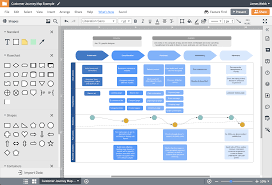Transform Customer Journeys with Customer Experience Mapping Software
Introduction

In today’s competitive business landscape, delivering exceptional customer experiences is a key driver of success. Customers expect seamless, personalized interactions across multiple touchpoints, and businesses need the tools to meet these expectations. Enter customer experience mapping software and customer journey analytics, which work together to offer powerful insights into customer behavior and optimize the journey from start to finish.
This article explores how customer experience software and customer journey analytics help businesses understand, visualize, and improve the customer experience, leading to higher satisfaction, loyalty, and revenue.
What is Customer Experience Mapping Software?
Customer experience mapping software is a tool designed to create visual representations of the customer journey. This software maps out every interaction a customer has with a business, from their initial awareness of a product or service to post-purchase support. By highlighting key touchpoints, pain points, and opportunities for improvement, customer experience mapping helps businesses deliver more cohesive and impactful experiences.
The Role of Customer Journey Analytics
Customer journey analytics goes hand-in-hand with experience mapping. While mapping software provides a visual framework, journey analytics dives deeper into the data behind each touchpoint. This includes tracking customer behavior, preferences, and sentiments across channels to uncover patterns and trends.
When used together, these tools enable businesses to take a proactive approach to customer experience management by using bulk samsung M393A8G40AB2-CWE supplier, identifying issues before they escalate and optimizing journeys for better outcomes.
Benefits of Customer Experience Mapping Software
1. Enhanced Understanding of the Customer Journey
Mapping software provides a comprehensive view of the customer journey, helping businesses understand how customers interact with their brand at every stage.
2. Identification of Pain Points
By visualizing customer interactions, businesses can pinpoint areas where customers face challenges or frustrations, allowing them to make targeted improvements.
3. Improved Cross-Channel Consistency
Mapping ensures that customers have a seamless experience across all channels, whether they are engaging online, in-store, or through customer support.
4. Data-Driven Decision Making
When integrated with customer journey analytics, mapping software provides actionable insights that drive strategic decisions to enhance customer experiences.
5. Increased Customer Loyalty and Retention
By addressing pain points and optimizing journeys, businesses can foster loyalty and encourage repeat engagement, boosting long-term customer retention.
Features to Look for in Customer Experience Mapping Software
When selecting the right tool for your business, consider these essential features:
- Customizable Visual Maps
The software should allow businesses to create tailored maps that reflect unique customer journeys. - Integration with Analytics Tools
Integration with customer journey analytics ensures that maps are backed by data, offering deeper insights into customer behavior. - Omnichannel Support
Effective mapping software tracks customer interactions across all touchpoints, including websites, social media, email, and physical stores. - Collaboration Capabilities
To align teams across departments, the software should support collaboration, enabling stakeholders to work together on improving the customer journey. - Real-Time Updates
Real-time capabilities allow businesses to monitor changes in customer behavior and update their strategies accordingly.
How Customer Journey Analytics Enhances Mapping
Customer journey analytics provides the data needed to enrich and refine customer experience maps.
- Behavior Tracking: Analytics tracks how customers move through various touchpoints, identifying where they drop off or face challenges.
- Sentiment Analysis: By analyzing feedback, reviews, and social media mentions, businesses can gauge customer sentiments at different stages.
- Predictive Insights: Analytics tools forecast future customer behavior, helping businesses proactively address potential issues.
- Performance Metrics: Key performance indicators (KPIs) like conversion rates, response times, and satisfaction scores are linked to journey maps for measurable improvements.
Applications Across Industries
1. Retail and E-commerce
Retailers use mapping software to track online and in-store customer journeys, ensuring a seamless shopping experience at Amazeshop. For example, mapping can identify areas where customers abandon carts, enabling targeted interventions.
2. Healthcare
Healthcare providers use these tools to improve patient experiences, from appointment scheduling to post-treatment follow-ups.
3. Banking and Finance
Banks leverage mapping and analytics to enhance digital banking experiences, streamline account opening processes, and improve customer support interactions.
4. Travel and Hospitality
Hotels and airlines use journey mapping to personalize guest experiences, optimize booking processes, and ensure hassle-free travel.
Real-Life Impact: A Case Study
A leading e-commerce company implemented customer experience mapping software integrated with customer journey analytics to address a high cart abandonment rate.
- Mapping Findings: The software revealed that customers abandoned carts due to unclear shipping policies and complicated checkout processes.
- Analytics Insights: Customer journey analytics showed that customers spent excessive time on the checkout page, leading to frustration.
- Solution: By simplifying the checkout process and providing transparent shipping information, the company reduced abandonment rates by 25% and boosted overall conversions.
The Future of Customer Experience Mapping
The future of customer experience software lies in advanced technologies like artificial intelligence (AI) and machine learning (ML). AI-powered tools can automatically analyze customer data, identify emerging trends, and suggest improvements to the customer journey.
For instance, AI could detect when customers frequently switch between channels during their journey and recommend solutions to enhance cross-channel consistency.
Conclusion
Investing in customer experience mapping software and customer journey analytics is essential for businesses seeking to stay competitive in a customer-centric world. These tools empower organizations to visualize customer interactions, analyze behavior, and optimize every touchpoint to deliver exceptional experiences.
By combining the visual clarity of mapping software with the deep insights of journey analytics, businesses can foster stronger relationships with their customers, driving loyalty, satisfaction, and long-term growth. In today’s dynamic marketplace, these tools are no longer a luxury—they’re a necessity.



